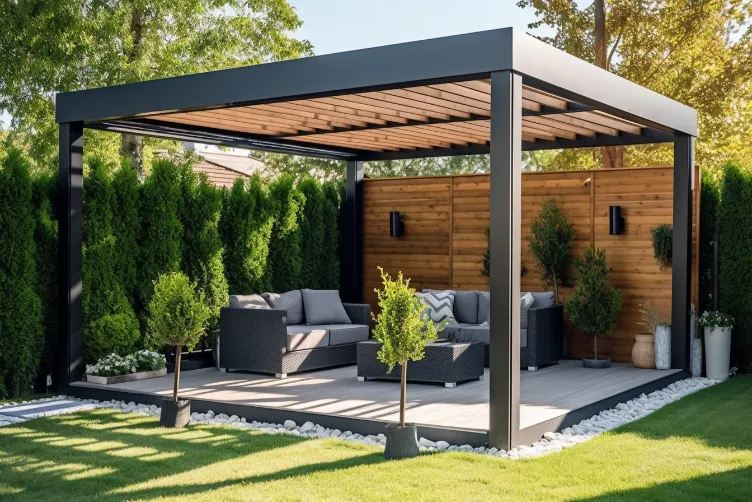Introduction
Pergolas are a cherished enhancement for outdoor areas. They offer shade, boost aesthetic charm, and bring an essence of sophistication. Yet, their durability can differ greatly. This variation is due to numerous influences. In the following text, we delve into the pivotal factors affecting pergola longevity. Our focus lies on selecting appropriate materials. Additionally, we consider climatic and environmental conditions. The quality of construction also plays a crucial role. Furthermore, we emphasize the significance of regular maintenance and care. By comprehending these components, you’re empowered to make well-informed choices. These decisions ensure your pergola not only endures but also continues to beautify your outdoor space.
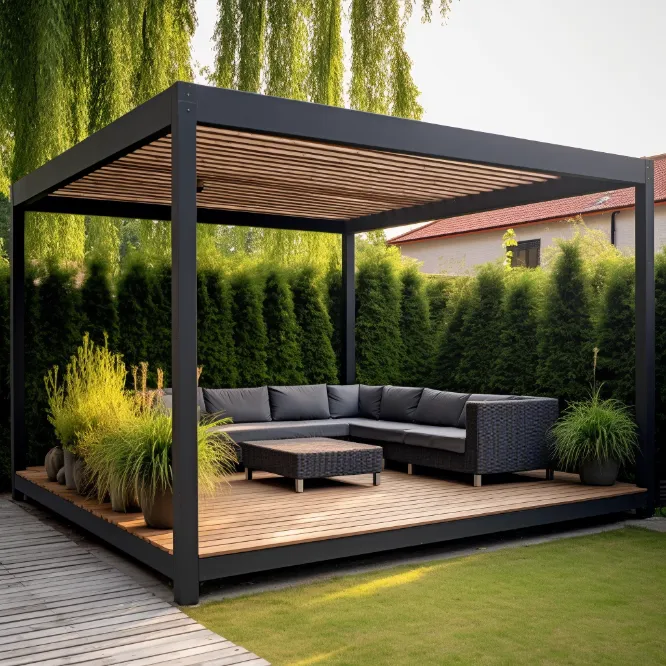
Factors Influencing Pergola Lifespan
Material Choice
Selecting the optimal material is crucial for your pergola’s enduring success. Various materials boast distinct lifespans. Notably, WPC and aluminum necessitate less upkeep, whereas wood demands more attention. Here are the key points:
- WPC and aluminum provide robustness with minimal maintenance.
- Pressure-treated wood, though aesthetically pleasing, requires consistent care.
- WPC and aluminum maintain their strength even in severe weather.
- The material you choose influences both sturdiness and maintenance demands.
Climate and Environmental Conditions
The climate in your area and environmental elements significantly shape your pergola’s longevity. Factors such as weather exposure and diligent maintenance are essential for its durability. Here’s why:
- Elements like sun, rain, wind, and temperature variations affect its lifespan.
- Cedar wood is prone to environmental degradation.
- Routine cleaning, staining, and sealing are crucial for damage prevention.
- Certain pergolas are crafted to endure all climatic challenges.
Quality of Construction
The skill in construction and the caliber of materials used in your pergola are pivotal. Superior craftsmanship can enhance its lifespan. Conversely, subpar construction might lead to rapid deterioration. Consider these reasons:
- Expertise in craftsmanship and high-quality materials are fundamental.
- Bespoke pergolas, built by professionals, can endure for over two decades.
- Substandard building methods can reduce your pergola’s lifespan.
- The material selection significantly affects its robustness.
Maintenance and Care
Attentive maintenance and care are indispensable for extending the life of your pergola. This is true irrespective of the chosen material. Specific maintenance practices and material-related upkeep are critical. Here are the details:
- Aluminum demands less care in comparison to wood.
- Regular cleaning, along with staining and sealing, guards against weather impacts.
- Preventing issues like chipped paint prolongs your pergola’s life.
- Materials like cedar wood or aluminum require unique maintenance procedures.
In conclusion, the choice of materials notably influences your pergola’s durability. Options like iron and aluminum are notably resilient. Local environmental conditions necessitate ongoing maintenance and safeguarding measures. Quality construction, coupled with proper upkeep, is essential. Tailored maintenance for specific materials further maximizes your pergola’s lifespan.
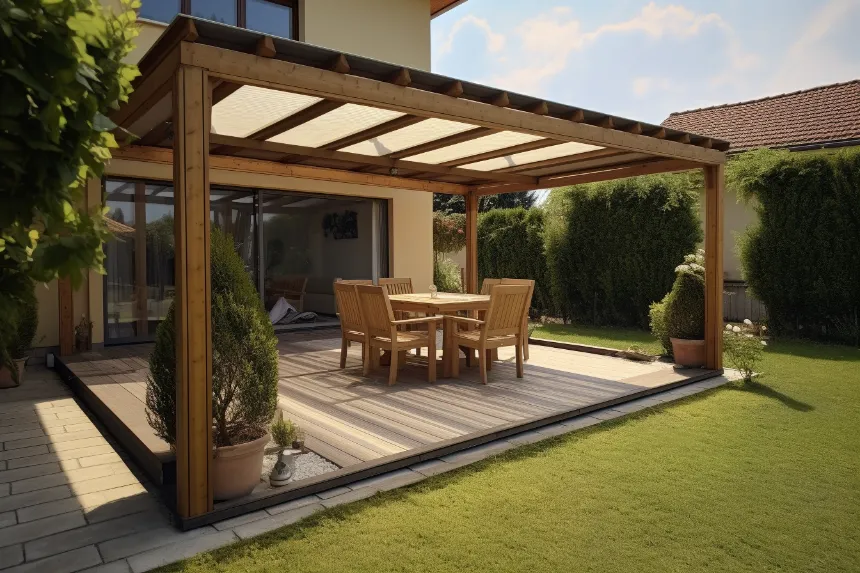
Wood Pergolas Life Span
The durability of wood pergolas varies greatly, leading us to ask: what is their typical lifespan? Several factors influence this. The wood type, maintenance level, local weather, and construction quality are pivotal. With correct choices and attentive care, a well-kept wood pergola can last about 5-20 years or more. Conversely, neglect and harsh conditions can drastically shorten this time. Therefore, it’s crucial to recognize and manage these influential factors.
Pros and Cons of Wood Pergolas
Pros
- Wood pergolas boast a warm, natural allure. They greatly enhance the visual charm of any outdoor area.
- The versatility of wood facilitates customization in design and size. This makes it an ideal choice for personalized structures.
- Wood is a pliable material. Minor repairs are often simple, contributing to the pergola’s durability.
Cons
- The lifespan of wood pergolas is inconsistent. It depends on elements like wood type, upkeep, and climate. This variability may affect their long-term durability.
- Regular maintenance is crucial. Tasks such as staining, sealing, and treating rot and insect damage are necessary for keeping wood pergolas in prime condition.
- Wood is prone to weathering, rot, and pests. Therefore, diligent care is essential to extend its lifespan.
Factors That Impact the Longevity of Wood Pergolas
- Type of Wood: The wood selection greatly affects a pergola’s longevity. Hardwoods like cedar and redwood typically last longer. They have inherent decay resistance.
- Treatment and Maintenance: Treating wood and regular care, like resealing and staining, protect against rot and pests. This extends the pergola’s life.
- Climate and Location: Harsh weather or high humidity can hasten deterioration. Proper installation and placement become critical.
- Design and Quality of Construction: Durable, well-made pergolas are more resilient over time. Quality materials and craftsmanship are essential.
- Insects and Pests: Regular checks and pest prevention, such as termite control, are vital for wood preservation.
- Regular Cleaning: It’s important to keep pergolas clean. Dirt and moisture buildup can lead to decay.
- Annual Inspections: Yearly assessments for structural soundness and wear are necessary. They ensure timely maintenance and promote longevity.
Tips for Extending the Lifespan of Wood Pergolas
- Regular Cleaning: Use gentle detergent and a soft brush to remove grime and mildew. This helps maintain the wood’s look.
- Inspect for Damage: Quickly addressing scratches and dents prevents further harm. It also keeps the pergola looking neat.
- Sealing or Staining: Applying wood sealer or stain is crucial. It protects against rot, preserving both the structure and appearance.
- Prune Nearby Vegetation: Trimming plants prevents damage and reduces mold risk.
- Regular Inspections: Tightening or replacing loose components is key to maintaining structural strength.
- Protection from Sun and Rain: Shade solutions can shield the wood from excessive exposure.
- Proper Drainage: Effective drainage systems prevent water accumulation, which can cause rot.
- Annual Maintenance: Yearly care, including cleaning, resealing, and repairs, is essential.
- Insect Control: Employ treatments or barriers against wood-boring insects.
- Use Quality Materials: Opting for high-quality wood and materials during construction and repairs enhances durability.
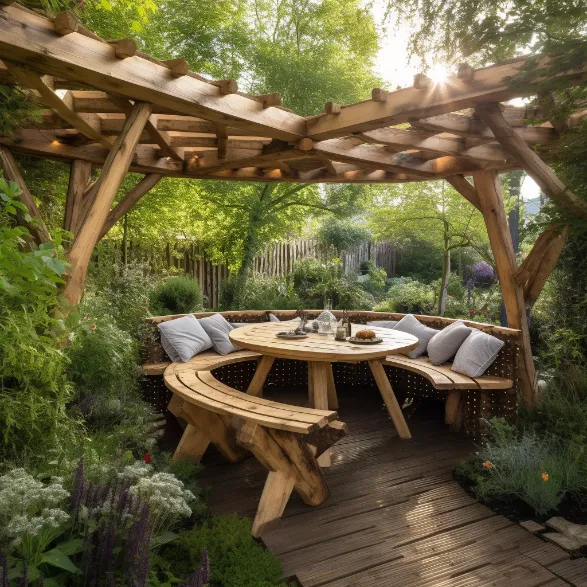
Aluminum Pergolas Life Span
The durability of aluminum pergolas hinges on several elements. These include diligent maintenance, the prevailing climate, and the caliber of construction. Typically, a well-kept aluminum pergola endures for multiple decades. This often translates to approximately 15 to 20 years, if not more. Nonetheless, individual outcomes may vary. Hence, prioritizing meticulous care and superior construction quality is pivotal to maximize your aluminum pergola’s longevity.
Pros and Cons of Aluminum Pergolas
Pros
- Exceptional Durability: Aluminum pergolas are highly durable, resisting corrosion and harsh weather conditions, ensuring a long lifespan.
- Low Maintenance: They require minimal upkeep, reducing the risk of deterioration over time, making them a hassle-free option.
- Long Lifespan: Typically, aluminum pergolas can last around 15 to 20 years or more, providing long-term use and enjoyment.
- Lightweight and Easy Installation: The lightweight nature of aluminum makes installation easier and doesn’t overburden your outdoor space.
- Versatile Designs: Aluminum pergolas come in various designs and can be customized to suit your preferences and space.
Cons
- Higher Initial Cost: Aluminum pergolas may have a higher upfront cost compared to some other materials, like wood, which can be a consideration for budget-conscious individuals.
- Modern Appearance: Some may prefer the natural and traditional look of wood, so aluminum might not be the best choice for those seeking a classic aesthetic.
Factors That Impact the Longevity of Aluminum Pergolas
- Climate: The local climate plays a crucial role in the lifespan of an aluminum pergola, with extreme conditions potentially affecting its durability.
- Location: Proper placement in your yard is essential; pergolas exposed to direct sunlight, rain, or other elements may experience more wear and tear.
- Maintenance: Regular cleaning and prompt issue resolution significantly extend the lifespan of an aluminum pergola.
Tips for Extending the Lifespan of Aluminum Pergolas
- Regular Cleaning: Periodic hosing down to remove dirt and debris keeps your pergola looking fresh and maintains its structural integrity.
- Routine Maintenance: Use a bristle brush and mild cleaning solution for regular upkeep.
- Inspect for Damage: Regularly check for rust, loose fasteners, or worn components, addressing issues promptly.
- Repainting: Renew the finish if it fades or chips, offering extra protection against the elements.
- Lubricate Moving Parts: If your pergola has moving components, such as a retractable canopy, lubricate them to prevent rust and ensure smooth operation.
- Avoid Harsh Chemicals: Use mild, non-abrasive cleaning solutions to protect the aluminum finish.
- Trim Vegetation: Regularly trim vines or plants to prevent overgrowth that can damage the structure.
- Address Water Drainage: Ensure proper water drainage to prevent rust and other damage.
- Protect from Extreme Weather: During severe conditions, secure loose parts to prevent damage.
- Professional Inspection: Periodic professional inspections and maintenance can ensure long-term durability.
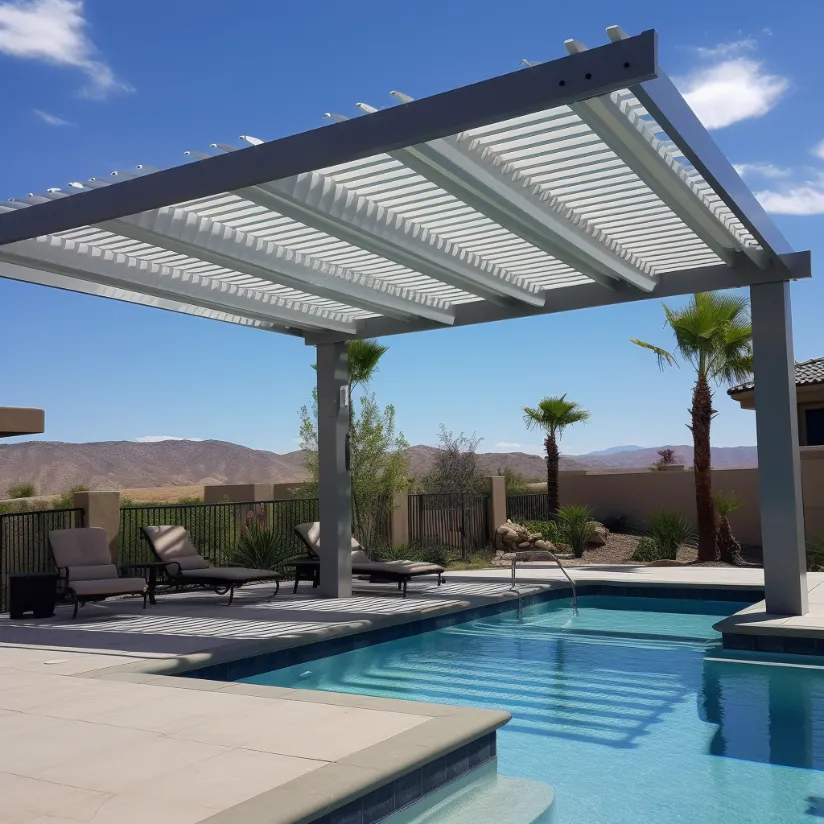
WPC Pergolas Life Span
WPC (Wood-Plastic Composite) pergolas boast an attractive, durable design for outdoor areas. Their longevity varies, commonly between 10 to 30 years. This variation stems from factors like WPC material quality, maintenance, and environmental conditions. Today, let’s delve into WPC pergolas‘ advantages and drawbacks. We’ll examine factors impacting their durability and provide essential tips to prolong their life. Our goal is to ensure your outdoor sanctuary remains both stunning and functional for the foreseeable future.
Pros and Cons of WPC Pergolas
Pros
- Modern Aesthetics: WPC pergolas enhance outdoor areas with a chic, contemporary flair.
- Low Maintenance: These structures resist moisture and corrosion, requiring scant cleaning.
- Durability: WPC’s inherent sturdiness combats rot, decay, and termites, guaranteeing an enduring build.
- Eco-Friendly: Many WPC materials utilize recycled resources, reflecting an eco-conscious choice.
Cons
- Initial Cost: Setting up WPC pergolas initially may incur greater expenses than traditional wood.
- Synthetic Look: Some may prefer wood’s natural charm over WPC’s artificially aesthetic.
- Heat Retention: WPC, akin to other composites, can absorb heat, potentially causing discomfort in high temperatures.
Factors Influencing WPC Pergolas’ Durability
- Material Quality: The robustness of WPC pergolas largely hinges on the material’s caliber.
- Weather Resistance: WPC’s resilience against climatic elements contributes to its extended lifespan.
- Low Maintenance: Minimal upkeep reduces deterioration risks over time.
- Proper Installation: Correct installation techniques and designs prevent longevity-impacting issues.
- Environmental Resistance: Effective defense against wind, moisture, and rain is vital for durability.
- UV Resistance: UV-protected WPC remains less prone to sun-induced fading or damage.
Enhancing WPC Pergolas’ Lifespan
- Regular Cleaning: Consistently clean your pergola to avert dirt and mold buildup.
- Staining and Sealing: Apply protective coatings to guard against UV rays, moisture, and environmental factors.
- Gentle Cleaning: Utilize mild detergents and a soft brush to avoid harming the WPC.
- Damage Inspection: Routinely inspect for any signs of damage and address them swiftly to prevent exacerbation.
- Ongoing Maintenance: Adhere to a maintenance schedule that includes inspections and repairs.
- Correct Installation: Ensure the pergola’s installation aligns with manufacturer specifications.
- Weather Precautions: Implement measures during extreme weather, like snow removal and securing components.
- Vegetation Management: Periodically trim plants and vines to protect the structure.
- Weight Management: Avoid overburdening the pergola with excessive weight to prevent stress on the structure.
- Quality Materials: Opt for high-grade WPC materials for construction or repairs to endure outdoor conditions.
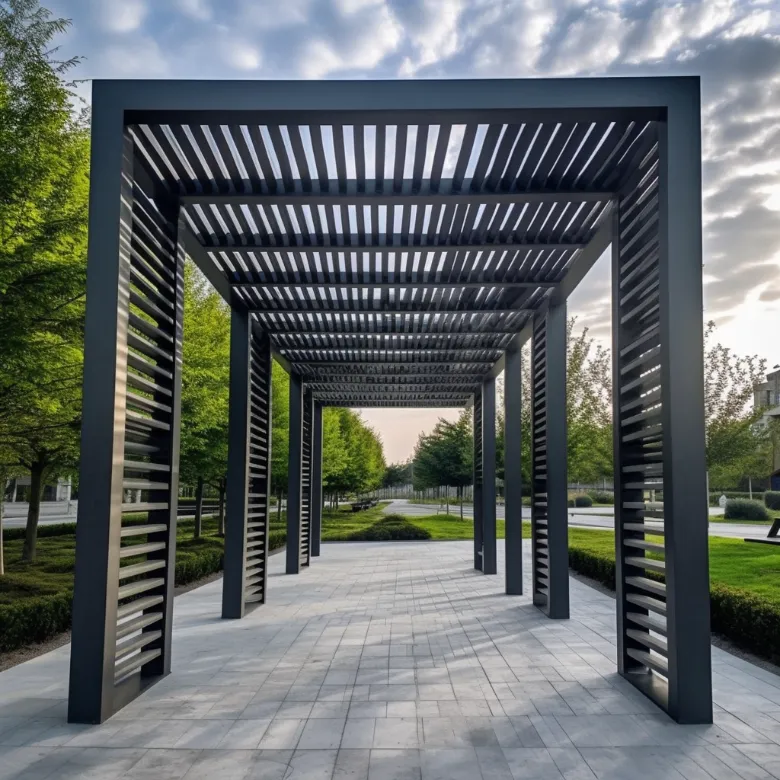
Iron Pergolas Life Span
The longevity of iron pergolas depends on multiple factors. These include the quality of materials and the level of maintenance. Additionally, climate and location play crucial roles. Typically, with consistent care, iron pergolas endure for 20 to 50 years or more. Yet, their lifespan can be impacted by various advantages and drawbacks. Furthermore, specific measures can enhance their durability. Now, let’s examine the factors influencing iron pergolas’ sturdiness. We’ll also uncover effective strategies to ensure their lasting presence.
Pros and Cons of Iron Pergolas
Pros
- Durability: Known for robustness, iron pergolas withstand decades with adequate upkeep.
- Low Maintenance: Unlike wood, they require minimal care. They’re impervious to rot and insects. Additionally, rust prevention and painting can prolong their life.
- Initial Investment: Though costly at first, their extended lifespan and sturdiness make up for the initial expense.
Cons
- Rust Vulnerability: Neglected maintenance may lead to rust, reducing their longevity.
- Weight Considerations: Heavier than aluminum, iron pergolas need strong supports. Improper installation could affect their lifespan.
- Less Common: They’re rarer because they tend to warp over time, impacting their overall longevity.
Factors That Impact the Longevity of Iron Pergolas
- Choice of Materials: The iron type is crucial in determining a pergola’s life.
- Maintenance: Regular cleaning and protective treatments are vital against rust and corrosion.
- Weather Conditions: Harsh weather accelerates deterioration. Weatherproof coatings are beneficial.
Tips for Extending the Lifespan of Iron Pergolas
- Regular Cleaning: Maintain cleanliness to prevent corrosion.
- Damage Inspection: Quickly fix any damage to prevent rust.
- Protective Coatings: Use finishes or coatings for rust and corrosion protection, especially outdoors.
- Regular Maintenance: Keep bolts tight and lubricate hinges and joints.
- Repainting: Repaint as needed for appearance and protection.
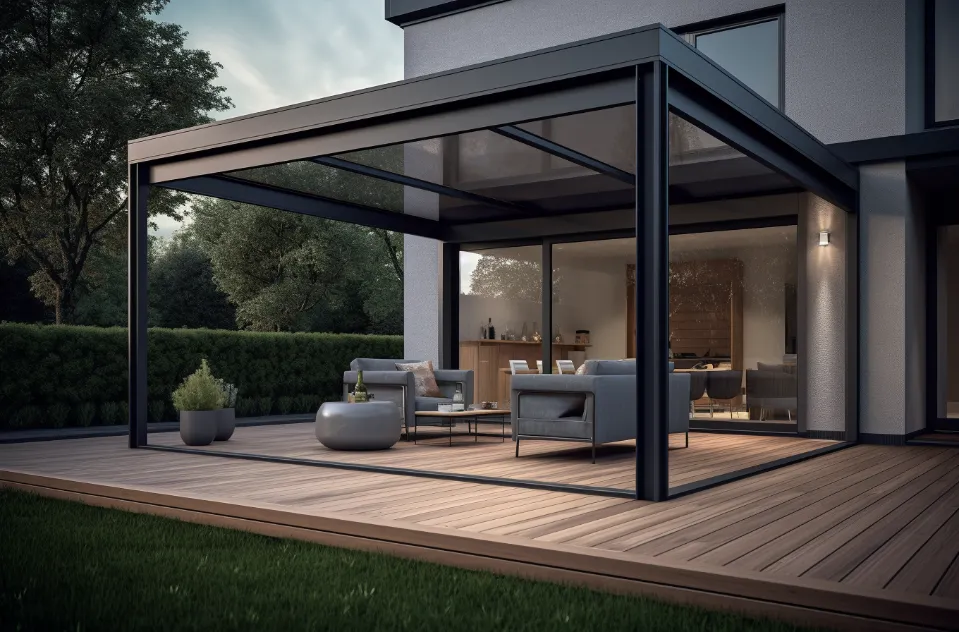
The Role of Climate in Pergola Lifespan
Climate significantly influences the durability of a pergola. Each climate presents unique challenges, impacting these structures’ resilience. Let’s examine how various climates affect pergolas. We’ll also identify strategies to protect them against harsh weather. Understanding this climate-pergola lifespan connection is key for homeowners. Especially for those wanting to optimize their outdoor areas.
How Different Climates Affect Pergolas
- Humid Environments: Pergolas in high humidity areas risk wood rot and mold. Wooden structures in such climates degrade more rapidly. Therefore, consistent upkeep is imperative.
- Rain-Prone Areas: Regular rainfall speeds up degradation, especially in wooden pergolas. Neglecting maintenance can result in a reduced lifespan in these regions.
- Intense Sun Exposure: In sunny regions, pergolas face fading, warping, and cracking. Maintenance and protective sealants are essential to combat sun damage.
- Extreme Heat Zones: High temperatures can weaken materials, compromising pergola stability. Without intervention, this can shorten their lifespan.
- Adverse Weather Conditions: Pergolas in windy, salty, or snowy areas experience increased wear. Constructing and maintaining these pergolas requires special attention.
Strategies for Dealing with Extreme Weather Conditions
- Regular Maintenance: Clean your pergola regularly, especially in dusty areas, to avoid damage.
- Weather Sealing: Use suitable sealants for protection, tailored to your specific climate.
- Wind Protection: Strengthen your pergola against winds. Opt for wind-resistant designs and robust materials.
- Rain Protection: Protect your pergola from rain with a roof, waterproof materials, or retractable awnings.
- Long-Term Maintenance: Maintain its longevity through ongoing care. This includes wood staining, sealing, and frequent inspections.
- Consider Weather-Resistant Materials: For enhanced durability, select materials like stainless steel or aluminum for construction or renovation.

Why Construction Quality Matters And Affects Pergolas’ Lifespan?
Construction quality is crucial for a pergola’s lifespan. It involves selecting the right materials, maintaining them, and using appropriate construction methods. Recognizing construction quality’s importance is vital. We must identify signs of poor craftsmanship. Additionally, making informed choices about DIY or professional building is key. These decisions ensure your pergola’s enduring beauty and functionality:
- Proper construction methods are essential for your pergola’s longevity.
- The materials you select, such as wood, iron, or aluminum, greatly affect its lifespan.
- Consistent upkeep, including repainting and cleaning, is critical in maintaining its structural soundness.
- Regular cleaning and debris removal can avert lasting damage.
- Secure installation, using the correct anchoring and hardware, is imperative for structural integrity.
- Adding protective elements like rain covers or UV-resistant roofing defends against weather-related harm.
- Watch for poor construction indicators, such as substandard materials, weak joints, drainage problems, uneven surfaces, and design errors.
- It’s important to ensure your pergola doesn’t block views from your windows, preserving your property’s visual appeal.
- In deciding to DIY or hire professionals, weigh factors like cost, expertise, time, quality, and personalization.
- Ultimately, your decision should match your budget, skill set, and desired quality and customization level. Proper techniques and materials are crucial, as is the decision-making process.
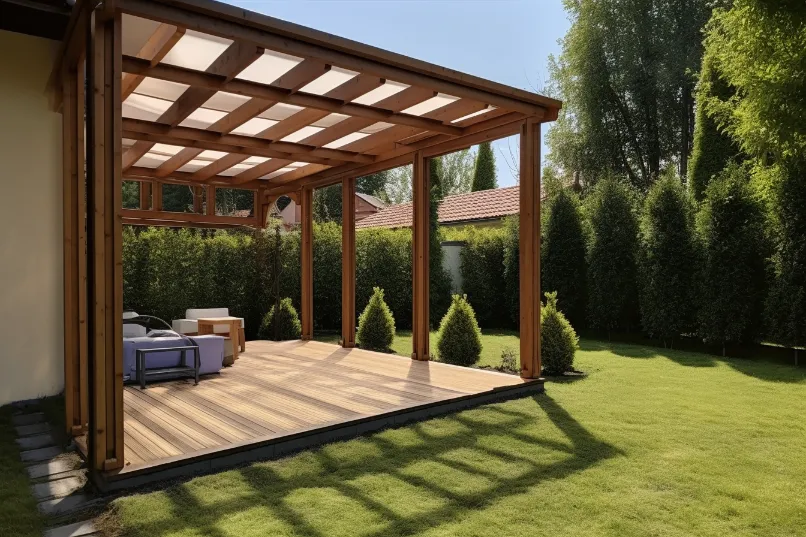
Why Maintaining Your Pergola Increases Its Life Span?
Preserving your pergola is crucial for prolonging its life. Here’s why various upkeep tasks, including consistent cleansing, thorough inspections, application of stains, seals, paints, rust prevention, and periodic cleaning, are fundamental in guaranteeing your pergola withstands the test of time:
- Regular Cleaning and Inspections: Consistently cleaning and examining your pergola hinders the build-up of grime, debris, and fungus. This action not only maintains your pergola’s immaculate condition but also helps in promptly identifying and resolving emerging problems.
- Staining, Sealing, and Painting: Furnishing your pergola with a protective coating—be it stain, sealant, or paint—serves as an armor against harsh elements. These applications shield the timber from moisture, ultraviolet rays, and external factors, thwarting rot and decay while enhancing its visual appeal.
- Rust Prevention and Coating: For pergolas with metallic parts, averting rust is imperative. The use of anti-corrosion treatments fortifies against deterioration, upholding both structural robustness and aesthetic appeal.
- Cleaning Enhances Longevity: Annual or as-needed cleaning sessions rejuvenate your pergola. Eradicating accumulated dirt, grime, and mold is not just about aesthetic upkeep; it also plays a crucial role in preventing material degradation over time.
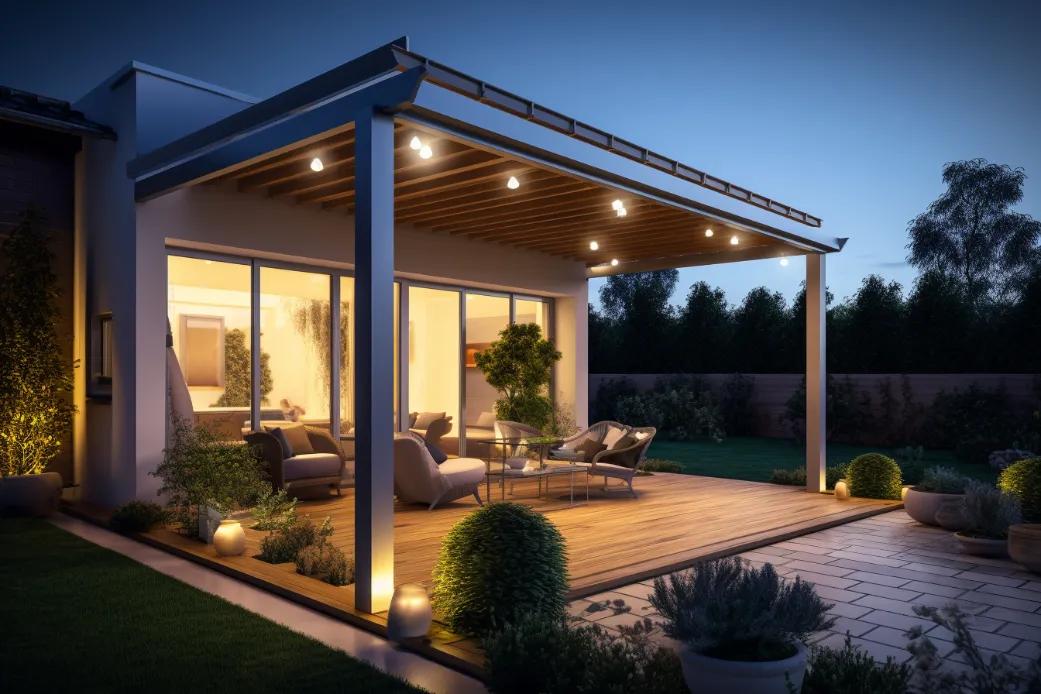
Conclusion
In the domain of outdoor decor, pergolas are both practical and visually appealing. However, their longevity isn’t guaranteed. Various elements influence their durability. These include the materials selected, your local climate, the quality of construction, and your maintenance efforts. Significantly, the material choice is pivotal. You might opt for wood’s classic beauty, aluminum’s resilience, WPC’s contemporary look, or iron’s sturdiness. Comprehending these elements and adhering to essential upkeep protocols can significantly extend your pergola’s lifespan. Therefore, as you commence your pergola project, whether installation or upkeep, remember that its lastingness is achievable through your efforts.

